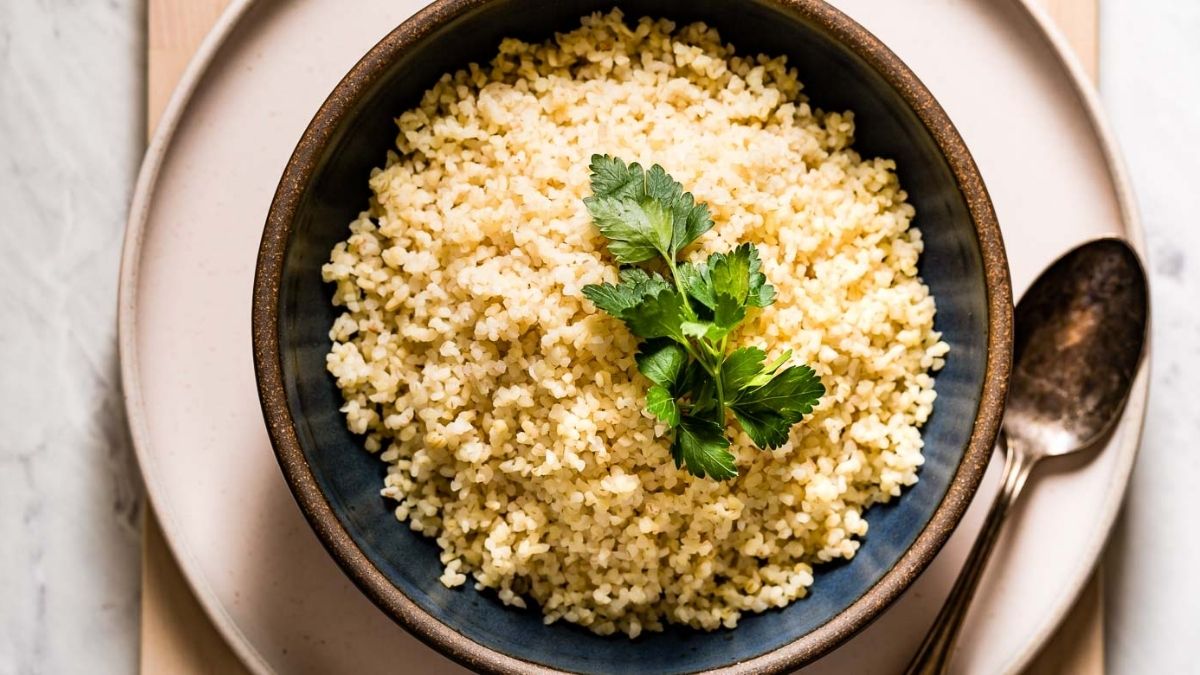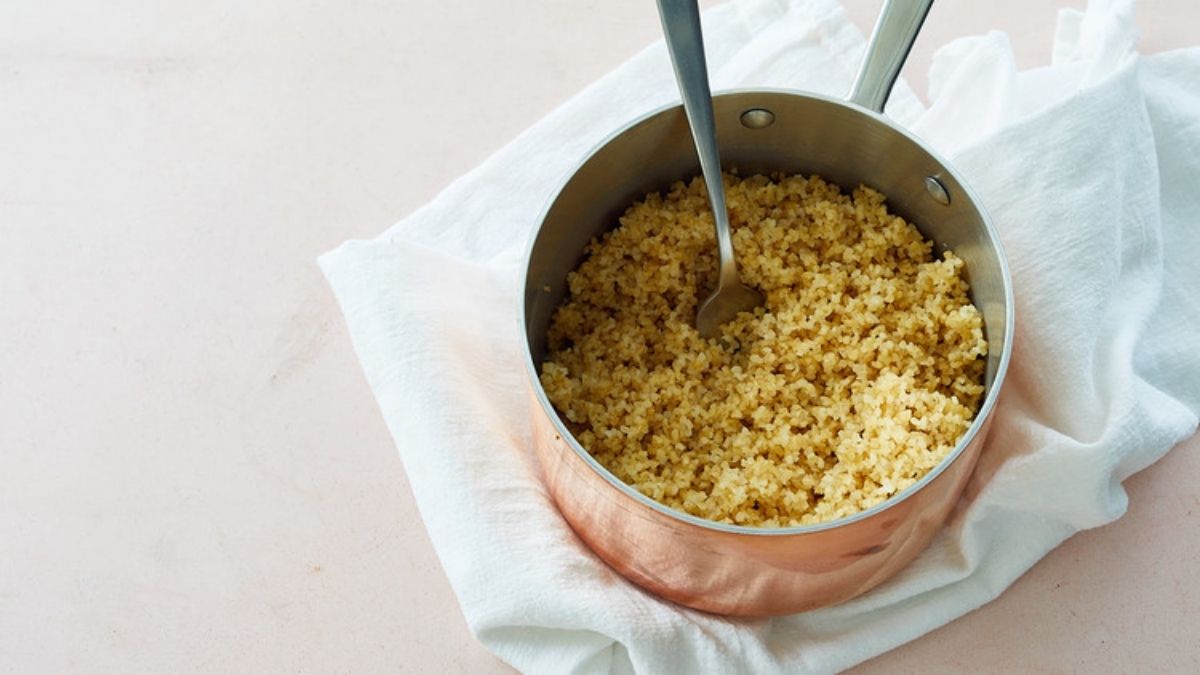Bulgur is made by partially boiling, cracking, and drying the kernels or seeds of wheat. The thing is, how to cook bulgur? They are taken from the head of a wheat stalk, which is fluffy and has up to 50 kernels in it. Bulgur is most often used in the classic Middle Eastern salad tabbouleh when it is fully cooked. The best thing about bulgur is how easy it is to use. Bulgur’s nutty flavor and hearty texture make it a great addition to many dishes. You can also use bulgur instead of other grains like brown rice, couscous, or quinoa.
What is Bulgur?
Bulgur is a type of whole wheat that has been cleaned, steamed, parboiled, dried, and then ground into grains of different sizes. It is also called bulgar, bulghur, and burghul. Any wheat can be used to make it, but durum is the most common.
The processing of wheat into bulgur is believed to have begun in the area of Mediterranean. This form has been part of the Middle Eastern diet for millennia, with references in the Old Testament literature that identify it with Hebrew, Babylonian, and Hittite peoples. Other ancient civilizations, such as the Romans and Egyptians, ate bulgur as early as 1000 B.C.
Bulgur is cooked, unlike broken wheat, which is often called bulgur. This makes meal prep easy. After ten minutes of boiling, bulgur can be eaten like pasta. Fine, medium, coarse, and whole-grain bulgur are available.
There are different uses for the different sizes. Bulgur is used in hot breakfast cereals and desserts when it is finely ground. For tabbouleh and other salads, stews, multigrain bread and other baked goods, and vegetarian burgers, it’s best to use medium-ground flour. Varieties that are not finely ground can be used in salads, pilafs, casseroles, and stuffing.
Whole grains can be added to baked goods or made soups and stews. This wheat tastes delicious and a little bit nutty. It’s a good source of protein, iron, magnesium, and B vitamins. It has a lot of fiber; a 1-cup serving (182 g) of cooked bulgur has 8 grams of fiber and very little fat. You can use it instead of converting rice into casseroles and other dishes to make them healthier.
How to Cook Bulgur?
Bulgur wheat is very simple to prepare.
It’s available in fine, medium, or coarse varieties and takes about 5–20 minutes to cook, depending on the type and cooking method. The coarser the grain, the longer the cooking time. Most brands of bulgur provide cooking directions, so it’s best to check the package first for specific instructions. Still, if you bought bulgur in bulk or don’t have any suggestions, there are a few basic bulgur cooking methods you can use.
To prepare about 3 cups (546 grams) of cooked bulgur at home, follow these steps:
On the Stovetop
In cooking, boiling water softens the grain, like rice or couscous. About two parts of liquid are needed for every aspect of the bulgur.
- Combine 1 cup (182 grams) of bulgur wheat with 2 cups (475 mL) of water or broth, and bring to a boil.
- Once boiling, reduce the heat to a lower simmer and cover.
- Cook for 10–15 minutes, until the water, has evaporated and the bulgur is tender.
In the Microwave
Microwaving bulgur may be the fastest way to cook it, and it doesn’t hurt the final product in any way, but it may have a different texture than bulgur cooked on the stovetop.
- In a bowl that can go in the microwave, mix 1 cup (182 grams) of bulgur wheat with 2 cups (475 mL) of water.
- The bulgur and liquid should be cooked in the microwave for about 3 minutes.
- Take the food out of the microwave and let it sit for five more minutes.
- Change the time of cooking as needed. It may take longer to cook a coarse grain than a medium or fine grain.
To Rehydrate
Rehydrating fine-grain bulgur is a good way to make it work again. If the bulgur is coarse, it may take longer.
- Put 1 cup of bulgur (182 grams) in a bowl or serving dish.
- Slowly pour 2 cups (475 mL) of warm water or broth over the bulgur and mix.
- Let sit for 45–60 minutes until all the liquid is gone.
- Use it as you like after you fluff it with a fork.
What are the Uses of Bulgur?
Bulgur came from what is now Turkey. Over the years, different groups found ways to use this healthy grain.
- Bulgur is softened into a porridge and mixed with sugar and milk in Indian cooking. It is also made into a savory porridge by mixing it with vegetables and spices.
- Bulgur is used in the traditional Middle Eastern appetizer called tabbouleh or tabouli. This salad contains bulgur, tomatoes, parsley, mint, olive oil, and lemon juice.
- Some say that assure, also called Noah’s Ark pudding, is the oldest desert in the world because it is made with fruits, nuts, honey, and bulgur. Bulgur is also used to make meatballs called kofte in Turkey and kibbeh in Syria.
- Bulgur is still used in a lot of European and Asian dishes.
- It is often used with herbs, vegetables, spices, and sometimes other grains in salads and pilafs. It’s also a great glue for meatballs and burgers.
- Because bulgur wheat is chewy, you can use it instead of ground meat in dishes like tacos and chili to make vegan versions of those dishes. It can also be used in almost any recipe for rice, quinoa, couscous, or a similar grain.
- With or without meat, bulgur is a great base for soups, stews, breakfast porridge, and overnight oats.
How to Store Bulgur?
Like many other grains, uncooked bulgur should be kept in a container that holds air out, so it doesn’t get wet and grow mold. Put the container somewhere cool and dark for up to a few months. If you store your bulgur in an airtight container for an entire year, you won’t have to worry about it going bad. When cooked, bulgur can be stored in the refrigerator for up to a week.
Bulgur must be stored in airtight containers in a cool, dry place.
It will stay good for five to six months at room temperature or in the fridge. Frozen, it keeps indefinitely. Keep bulgur that hasn’t been cooked in a cool, dry, airtight container. Cooked bulgur can be kept in the fridge for a few days, but it will soon “weep” water and become watery.
What are the Health Benefits of Eating Bulgur?
Eating fiber-rich whole grains like bulgur regularly can help prevent disease and improve digestion, among other things.
May Promote Heart Health
Eating foods like whole grains, fruits, and vegetables high in fiber is good for your heart. Bulgur is no different. Multiple reviews have found that eating whole grains lowers the risk of chronic diseases like stroke, heart disease, and heart failure. In a study of 400 Jordanians, a high-fiber diet made up mostly of legumes and bulgur was found to help reduce the risk of heart disease.
It May Help Control Blood Sugar
Compared to refined grains, whole grains cause your blood sugar to respond less and your insulin levels to be lower. Some research suggests that whole grains may make the body more sensitive to insulin. People often think that fiber is to blame for these effects, but plant compounds in whole grains may also play a big role. Bulgur wheat has a lot of fiber and phytonutrients, which may help you control your blood sugar better.
May Support Digestion and Gut Health
When you eat whole grains like bulgur regularly, they can help good bacteria grow in your gut. Short-chain fatty acids (SCFAs), which are made by these bacteria, help keep the intestines healthy and ensure digestion works well. Also, eating enough fiber-rich foods like bulgur may help treat and prevent digestive problems like constipation.
May Promote Weight Loss
Even though weight is affected by many things, many studies show that eating a lot of fiber helps people lose weight and makes them less likely to gain weight.
Overall, no one knows for sure how dietary fiber affects weight. In some cases, the number of bacteria in your gut may be a factor. In other cases, other metabolic factors may also play a role. Some people feel fuller after eating fiber, which makes them eat fewer calories. Fibre may also affect how much energy their bodies use during the day.
We need more research to understand how fiber helps people lose weight fully. Still, eating bulgur with other fiber-rich foods as part of a healthy, well-balanced diet may help you stay at a healthy weight and be in good health.
What are the Different Varieties of Bulgur?
After boiling, cracking, and drying, the bulgur is sifted to separate the grains by size. There are four types of bulgur grains based on how big or small the bulgur is. The less time it takes to cook the grain, the finer it is.
1. Fine Bulgur
is added to recipes like tabbouleh and salads.
2. Medium Bulgur
Cereals, veggie burgers, dolmas (stuffed grape leaves), and porridge are all made with grains.
3. Coarser Bulgur Grains
are used for pilaf and for stuffing vegetables (like squash).
4. Very Coarse Bulgur
is used to make pilaf, soups, stews, veggie burgers, and Syrian kibbeh, the same as meatballs.
Does Bulgur have Any Downsides?
Even though most people can eat bulgur safely, it may not be the best choice for everyone.
Since bulgur is made from wheat, people with a wheat allergy or a disorder caused by gluten should not eat it. Instead, they can eat any of the healthy grains that don’t have gluten. Due to the insoluble fiber in bulgur, some people with long-term intestinal problems like inflammatory bowel disease (IBD) or irritable bowel syndrome (IBS) may be unable to eat it.
If you have IBD or IBS and don’t know how your body will react, start with a small amount to see how your body reacts. Also, if you have severe digestive symptoms because of an illness or infection, it’s best to wait until your symptoms improve before eating foods high in fiber.
Lastly, if you eat a lot of fiber and find that you can’t handle high-fiber foods well, you might find it helpful to cut back and add these foods slowly, in smaller amounts, until you can handle them better. You can also drink more water to help your body break down the fiber.
Conclusion
Cracked wheat is used to make bulgur, which is a whole grain, and it’s full of fiber, vitamins, and minerals. Foods with a lot of fiber, like bulgur, may lower the risk of getting a long-term illness, help you lose weight, and improve your digestion and gut health.
Bulgur is easy to cook and can be used in many dishes, like salads, stews, and bread. Eat it as part of a well-balanced diet to ensure your body gets all the nutrients it needs. Bulgur wheat is small, healthy grains that have already been cooked and dried and can be used right out of the package.
When the bulger is fully cooked, it has a chewy texture, a sweet, mild smell, and a nutty, earthy taste. When it is made, the grains are separated into four different sizes: fine bulgur, medium grind, coarse, and very coarse grind. Bulgur is a very versatile food that goes well with both sweet and savory ingredients.

